Once-between-turns pink powers were first introduced in Wingspan’s Core Set. Each Wingspan Expansion continues to introduce more pink-powered birds to the game.
- As a general rule, Wingspan pink powers increase in usefulness with increasing player counts. For each player in the game, there is more opportunity for a “once between turns” pink power to activate.
- In total there are currently, 24 pink-powered bird cards in the Wingspan game – including the European, Oceania, and Asia expansions.
- End of Round Teal Powers (introduced in the European Expansion) do not trigger pink powers.
- Pink powers cannot be activated when it is your turn, only when it is an opponent’s turn. Thus the term “Once Between Turns” (as printed the cards).
- Page 10 of the Wingspan Core Set rulebook covers Pink Powers and how to use them.
24. Turkey Vulture
If a Wingspan pink power is situational, the bird it’s attached to needs good general qualities to make it valuable when it’s just sitting there doing nothing. A one-point bird with a one egg nest is not good, even at zero food cost. Action cubes are far too valuable to spend on a bird with a payoff this small.
When designing the vultures, I think they overestimated how good a zero food cost was on these birds. Their powers are very thematic (scavenging the scraps leftover from successful predators) but far too conditional.
For Turkey Vulture to be useful:
- An opponent needs to have a predator.
- They have to use that predator consistently.
- That predator has to succeed with its power consistently. Predator Powers traditionally have low success rates.
To make matters worse, Turkey Vulture qualifies for very few bonus cards. At least it can be played in any habitat. Birds with this power should be played as a direct counter-play to obvious predator use.
As an aside, I think a good “fix” for the Vulture archetype would be to up their point value to three and change their power to trigger whenever an opponent plays a predator bird. Keep everything else the same.
23. Black Vulture
The issues that plague the Turkey Vulture also plague the Black Vulture; it’s restricted to the Forest, and for that, they gave it one more point.
22. Loggerhead Shrike
An opponent needs to take the Gain Food Action, AND they need to take a rat to trigger this power. This power is too situational to use effectively. At least it’s worth three points and has a four egg nest. If you have Rodentologist, this becomes an average play. The Anatomist bonus card likes this bird as well.
21. Australian Owlet Night Jar
It has the chassis of the Eastern Kingbird. An opponent needs to take the Gain Food Action, and then you gain a worm IF there is one available in the birdfeeder. At least worms are among the most common food types. If you have Rodentologist, this becomes a decent play, as the Night Jar becomes four points for one food. The Cartographer bonus card likes this bird as well.
20. Black Billed Magpie
The issues that plague Turkey Vulture also plague Black Billed Magpie. At least it has a three-egg star nest, so it has some potential to help secure a round bonus and qualify for all nest-based bonus cards. Its two wild food cost is thematic for a bird that will eat anything. Omnivore Specialist makes this bird a decent play.
Its star nest allows it to qualify for all of the nest-specific bonus cards, and it also plays well with Anatomist, Cartographer, and Prairie Manager bonus cards. One more point, two more eggs, and a star nest make this bird cost two wild food as opposed to the zero food cost of the Black Vulture.
19. Eurasian Tree Sparrow
The Eurasian Tree Sparrow card is Loggerhead Shrike with one less restriction to trigger its power. Your opponent just needs to take the Gain Food Action. Unfortunately, the wheat gain comes from the birdfeeder IF it is available at that moment, but at least it’s a more common food type. Unlike the Shrike, there isn’t any particular bonus card that makes this an enticing play, although it does get you 50% of the way to the bottom three points of the Cartographer bonus card.
18. Eastern Kingbird
This bird’s redeeming qualities are that it’s cheap and flexible in both food cost and habitat placement. At two points with a two-egg nest, it almost feels like an overpriced Vulture in practice. Your opponents will probably play a handful of Forest birds. You have no way of really knowing if this bird’s pink power will be effective in any given game. It’s much less effective in a two-player game, as a single opponent could likely ignore the Forest altogether depending on their cards.
I have found that the best uses for this bird are in the early game and in the absence of another strong Forest option. If you are going first, you have a better opportunity to play this bird where you need it and take advantage of your opponent’s early Forest plays.Eastern Kingbird works well with Viticulturalist and Cartographer, meeting 50% of the requirements to reach the bottom three points of those bonus cards, but there are still probably better options.
17. Eurasian Golden Oriole
Similar in function to Eurasian Tree Sparrow, the Eurasian Golden Oriole has the luxury of choosing between two different food types. In practice, this bird feels overpriced at a cost of three food. Its redeeming qualities are that it has a star nest (albeit a small one), and it picks up two points from Omnivore Specialist.
I’ve used this bird to good effect in three player games where there ended up being a steady stream of worms and cherries along with two opponents who were frequently using the Gain Food Action. Viticulturist, Cartographer, Diet Specialist, and all of the nest-based bonus cards and round goals make this a more desirable play when they’re a factor.
16. Sacred Kingfisher
The Sacred Kingfisher card is cheap and flexible in both food cost and habitat placement. A four egg nest is good. Your opponent needs to take the Gain Food Action to trigger its power, but this bird has a lot of options to choose from (worms, rats, and fish). However, these benefits come at a price as this bird is worth zero points. The Falconer and Rodentologist bonus cards fix that, tacking on two points each. Fishery Manager and Bird Bander also likes this bird.
15. Horned Lark
The Horned Lark is a vanilla bird with mediocre Wingspan pink powers, but five points with a four egg nest are decent for the cost of two food. Bird Counter makes this card worth seven points, which is good. Your opponents need to play birds in the Grasslands to trigger this power. Tucking from your hand is sub-optimal, and you don’t even get to replace the tucked card. However, it’s a decent bird to play under Prairie Manager.
14. Belted Kingfisher
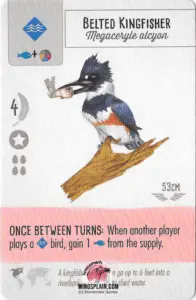
In the Core only metagame, this is a decent bird to play for its general qualities alone. Four points and a four egg star nest make this an enticing egg bank for securing multiple round bonuses and receiving eggs from other birds on this list. Omnivore Specialist makes it even better by tacking on two points. Fishery Manager, Wetland Scientist, and all of the nest-specific bonus cards make a bird card like this an enticing play. Its pink power is an afterthought. It’s like an Eastern Kingbird but gives you fish when your opponents play birds in the Wetlands. Too bad Eastern Kingbird doesn’t have similar general qualities that make it useful separate from its power.
13. Bronzed Cowbird
This card is the Brown-Headed Cowbird’s big brother. There isn’t much to say about this bird; it’s a vanilla five-point drop. A lack of a nest reduces its synergy with round bonuses and bonus cards. Nevertheless, if you can adequately support this bird with cup nests, it can be an effective, passive egg layer. This becomes especially important in the Oceania metagame. This a good drop under Prairie Manager.
12. Yellow-Billed Cuckoo
There’s not much to say about this bird; it’s Bronzed Cowbird, but better. The Yellow-billed Cuckoo is expensive for a five-point bird, but it has its own nest, unlike other parasitic nesters. Too bad it can’t lay eggs in its own nest. Omnivore Specialist bumps this bird up to seven points which is good. It also plays well with the Diet Specialist and Anatomist bonus cards, as it gets you 50% of the way to the first three points of those cards.
11. American Avocet
Cut from the same cloth as Yellow-Billed Cuckoo, but it’s worth one more point. This is one of the Wingspan pink powers that plays well with the Cartographer and Diet Specialist bonus cards.
10. Barrow’s GoldenEye
Also cut from the same cloth as Yellow-Billed Cuckoo. It has twice the nest capacity of the Cuckoo and American Avocet, though, which can be nice. The Historian bonus card adds two more points to this bird. It also plays well under Diet Specialist and Fishery Manager.
9. Horsfield’s Bronze-Cuckoo
This bird becomes a compelling play if you have either the Food Web Expert or Historian bonus cards, as they make this cuckoo four points for a single food drop. In the early game, you’re probably playing a lot of cheap birds that will qualify to receive an egg from this Cuckoo. Once again, the lack of a nest impacts the bird’s ability to synergize with bonus cards and round bonuses.
According to the Passerine Specialist bonus card, about 35% of the birds in the game qualify to receive eggs from this cuckoo’s power. Having its power tied to wingspans and not nest types take away these archetypes’ perk of interacting well with star nests. Although, it should be noted that several birds in the Oceania Expansion with wild wingspans qualify as a legal target for this bird.
8. Pheasant Coucal
This bird is unique among the Wingspan pink-powered egg layers in that it has a nest, and it can lay eggs on its own nest when your opponents take the Lay Eggs Action. Dropping this bird early in the game is a great way to potentially ignore laying eggs yourself. This allows you to invest those action cubes into acquiring other resources or building out your Forest or Wetlands.
It has a decent-sized nest, so it can actually leverage its power effectively, unlike other egg-laying birds (I’m looking at you, Thekla’s Lark). The fact that the Rodentologist bonus card bumps this bird up by two points is just icing on the cake. It also plays well with Prairie Manager.
7. Common Cuckoo
The Common Cuckoo is similar to Bronzed Cowbird in fit and function. Its distinction is that it can lay eggs in either cup nests or ground nests, which ends up being pretty useful in practice. This is among the best pink powered egg laying birds. In practice I have found this to be an effective bird. Pairing it with the Food Web Expert bonus card in Wingspan tacks on two more points.
6. Brown-Headed Cowbird
The power of the Brown-Headed Cowbird comes from its cheap food cost, its raw point value, and its ability to serve as a key element in early game acceleration that ignores the Lay Eggs action. You have to make sure you support it properly with a cup nest or star nest, though. It plays well under the Anatomist and Prairie Manager bonus cards. Three victory points for a single food is fairly efficient, as I discuss here: Wingspan Strategy: The 3/6/9 scale
5. Violet Cuckoo
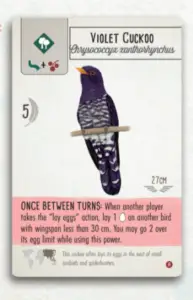
Violet Cuckoo has the same power as Horsfield’s Bronze-Cuckoo except that you may lay up to two eggs over the nest limit of the target bird! Any time you have a card that lets you break the normal rules of the game, keep an eye on it. This bird is built like Bronzed Cowbird. A five point bird with no nest, restricted to a single habitat, and costs two food. Forester and Vituculturalist are the bonus cards to look for with this bird.
4. Asian Koel
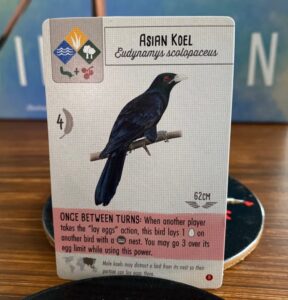
Asian Koel feels like a superior Violet Cuckoo. It has the same food cost and is worth one less point but it can be played into any habitat and it can lay up to three eggs over the limit of the target bird’s platform (or star) nest. This has pretty good synergy with platform nest birds since many of them can only hold one or two eggs.
3. European Goldfinch
European Goldfinch’s pink power lets you piggyback off your opponent’s tucking options. Tucking off the deck is generally better than tucking from your hand as the deck is theoretically infinite; your hand isn’t. You can set this bird and forget it while improving your board position and letting it harvest a point for you turn-after-turn (as long as an opponent is tucking).
There are only eight birds in the game worth six or more points that also hold four or more eggs; this bird is one of them. It may be worth playing even if your opponents aren’t tucking, especially if it lines up with a bonus card or round bonus. Just make sure to get some eggs on it. Bird Counter makes this an eight-point drop which is great. It also plays well under Viticulturalist, Diet Specialist, and Cartographer. As an aside, I’ve always thought this should have been the bird on the front of the European Expansion box instead of the Snowy Owl. It just pops.
I used to rate European Goldfinch higher than Snow Bunting on this list because of its strong general qualities. In practice though, the Goldfinch’s food cost makes it harder to get on the board in the early game and the Bunting’s card cycling power can be very powerful when supported with cards in hand.
Check out this “Snow Gold” Combo for more on this birds capabilities.
2. Snow Bunting
Snow Bunting’s general qualities are average, although it does become a seven-point drop under the Bird Counter bonus card, which is good. This bird piggybacks off your opponent’s tucking option by letting you tuck and draw yourself. As long as your opponents are tucking and you manage to keep a card in your hand, this is a great way to passively cycle cards, generate card advantage, and generate points for engines not rooted in the Wetlands. This type of tuck and draw card cycling effect is among the best powers in the game. This can make a great body to drop into your early Wetlands to help build out your card drawing infrastructure.
Check out this “Snow Gold” Combo for more on this birds capabilities.
1. Spangled Drongo
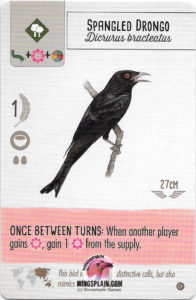
Spangled Drongo can be garbage or amazing, depending on how many opponents you’re up against. Its general qualities are Vulture-level bad. It does pick up two points from Omnivore Specialist, and it plays well under Diet Specialist, but you aren’t playing the Drongo for its bonus card interactions. You’re playing it for its power to passively generate one nectar for you from the general supply when an opponent gains nectar themselves by any means.
The only restriction on this power is your opponent’s decision on whether to take nectar or not and let’s face it; someone is taking nectar. Spangled Drongo is probably the biggest thorn in the side of the Common Raven and the Chihuahuan Raven cards in the Oceania Expansion metagame. It slaps Fish Crow and American Crow around too.
Anyone activating their Hummingbird for nectar is handing you two food that turn. That’s Raven-level resources, and it doesn’t cost you an action cube! This pink power is the type of power that justifies terrible qualities in all other aspects of a card. If its general qualities were average to great it might rank as God Tier on our Wingspan Card Tier List along with The Power 4.
Check out the results of our Spangled Drongo Poll.
Wingspan Pink Powers: What’s your favorite?
That’s our ranking of the 24 Wingspan Pink Powers!
I suspect that there will be some debate regarding our top three picks. Regardless, I think it would be hard to argue that those three aren’t the cream of the crop. Let us know what you think in the comments below. Don’t forget to see how we rank Wingspan Teal Powered birds and Wingspan Yellow Powered Birds.
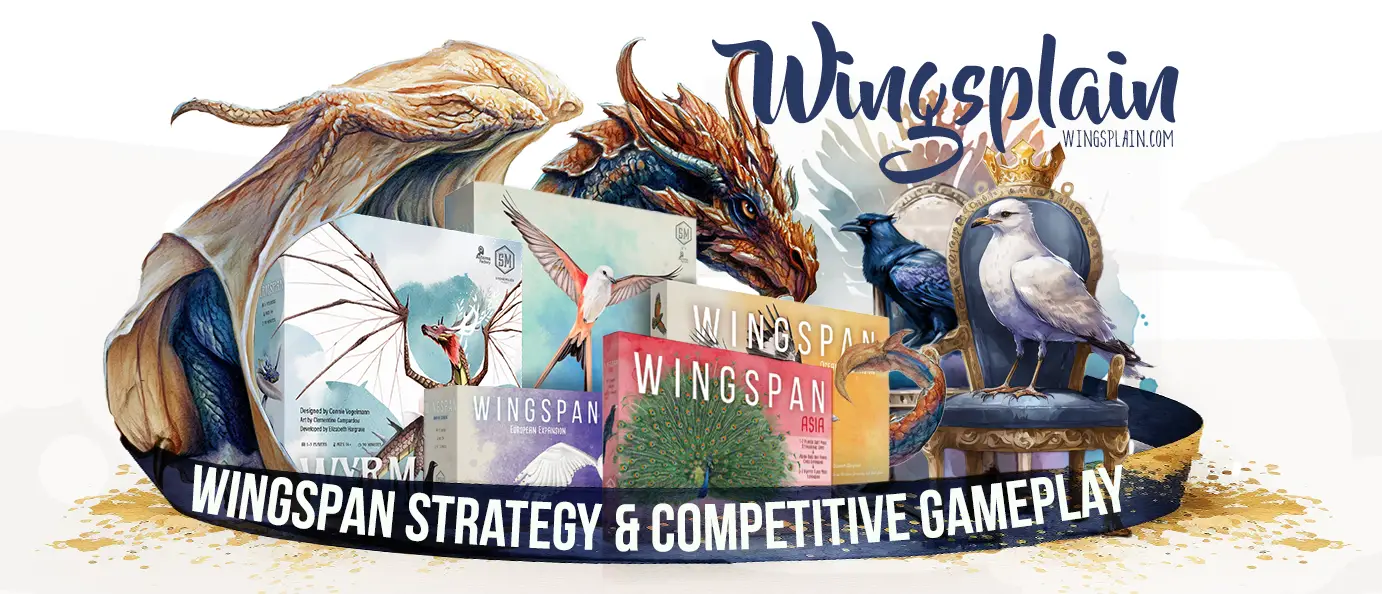
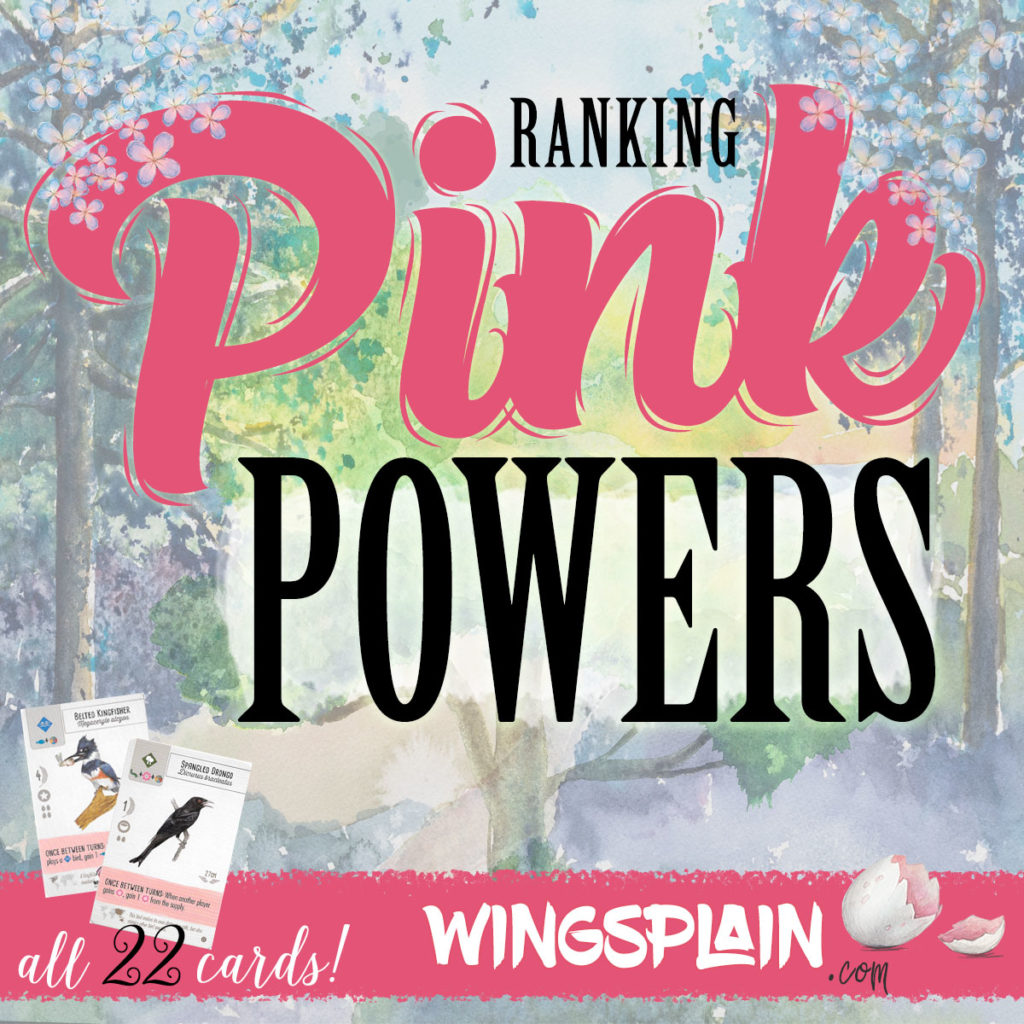
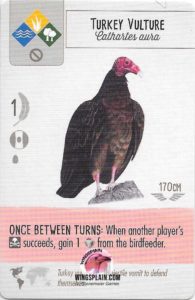
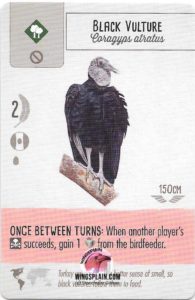
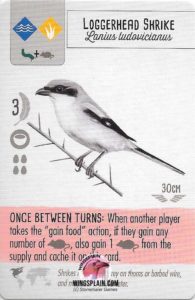
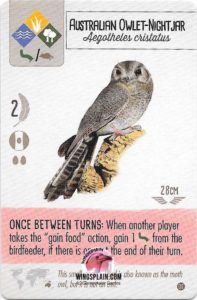
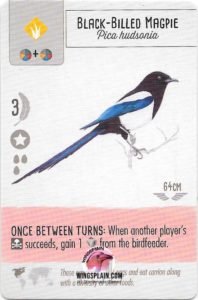
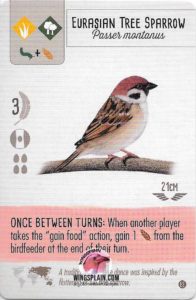
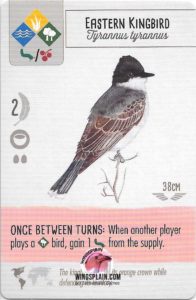
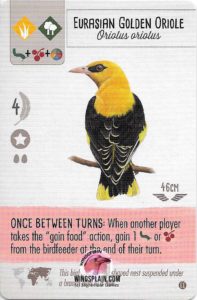
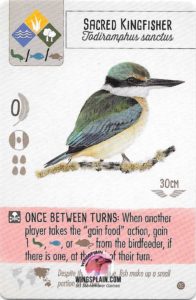
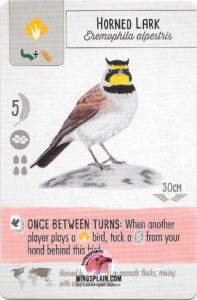
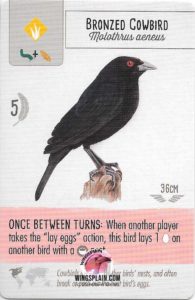
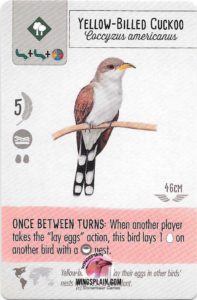
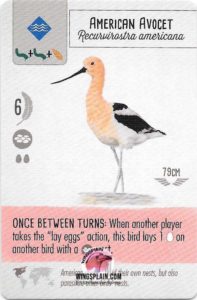
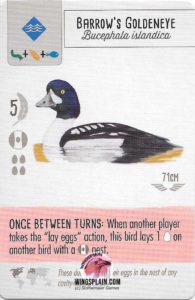
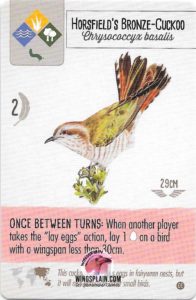
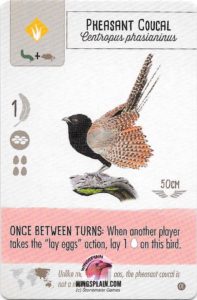
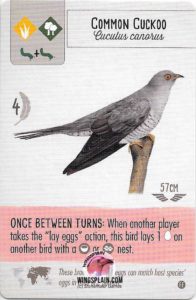
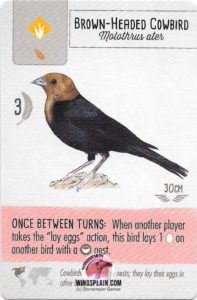
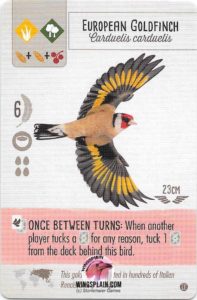
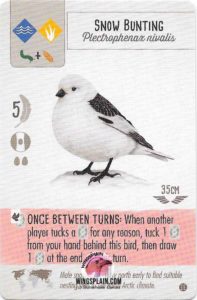
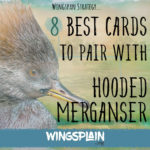
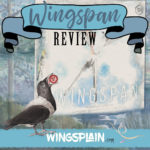
While I agree with your assessment of the vultures, I would put the Loggerhead Shrike at the very bottom. It almost never pays out, especially with nectar. People just don’t take rats. For the vultures, I’ll play them to advance my machine. Otherwise, if an opponent plays the Tawny Frogmouth or Rufus Owl, you can bet I’m playing a vulture if I get the chance. The Frogmouth is successful at least 90% of the time, and the Rufus Owl is successful 100% of the time. That’s a machine advancement while gaining a free food. That being said, the vultures are still kinda garbage. 🙂
Good choices for the top spots! I had a killer raven, sparrow setup in my grassland, and my wife completely negated it by playing the Drongo. Doh!
Vultures are definitely better against high success predators for sure. Good point about Frogmouth/Rufus Owl.
“As an aside, I think a good ‘fix’ for the Vulture archetype would be to up their point value to three and change their power to trigger whenever an opponent plays a predator bird. Keep everything else the same.”
Unfortunately it’s impossible to fix a printed game in the same way a videogame could be patched, so sadly this is out of question, but I still wish the vultures’ point cost would be a bit higher. After all, these are majestic birds, and it’s such a weird feeling to play a beast with a 3-meter wingspan that has a value like a common sparrow. 😀
On the trigger idea: ehh, I actually like how they feed only when other predators feed, it’s so appropriate and thematic! It is a weak ability, but it’s so annoying only due to being put on an already weak bird. I guessa zero-cost three-points bird would be much more tolerable even if ti provides just one or two food per game.
They had a really brilliant idea with Griffon Vulture, and for the next expansion they could use your idea of triggering when a predator enters the game!
Cheers!
I’m surprised that the European Goldfinch is your 3rd highest rated Pink card, but it’s only a Tier 1 card for you on your list. I tucked FIFTEEN CARDS last game with it – that’s amazing!
I think there’s a mistake with the black-billed magpie. It doesn’t qualify for Cartographer, it qualifies for Photographer. Great article, thank you!
Thanks for pointing that out!
The vultures are really good if played early in a 4-5 player game, much better than the horned lark and such in my experience. I’ve seen them be game-winning on their own if multiple opponents have played hunters. Each food is worth about two points, generally speaking, so you get more benefit than the player activating their hunting power. Definitely situational, though – generally best played after multiple hunters are out but still in round 1.
Great breakdown of the pink powered bird cards! I loved how you ranked them based on their unique abilities and synergy with other cards. It’s fascinating to see the different strategies one can employ using these birds. Can’t wait to try out some of these combinations in my next game!
The Shrike and the Horned Lark are possibly my least-played of all birds.
The vultures are can be decent first-round birds in large player games, particularly if you’re food starved and need to get a bird down in the forest.
The Australian Night Jar is one of my favourite first-turn birds: cheap and in a 4-5 player game can yield 3 to 8 food in the first round, when it accelerate your game.
I find that many my games with scores north of 160 benefit from having 2 egg layers to avoid the Prairies. North of 185 tends to include the European Goldfinch, the Snow Bunting, or both. Once I tucked 35 cards across them, but low to mid 20s is fairly common.
Games north of 200 tend to be those where I play 4 pink-power birds yielding eggs and food in the first round. The early pinks help earn enough resources to pay for the later pinks, while one otherwise searches for cards, avoiding the forest and prairies entirely.
Those are some pretty high-scoring games. I’ve never scored more than 158 myself and I’ve only ever scored in the 140’s two times. I’ve hit the 130’s about five times or so.